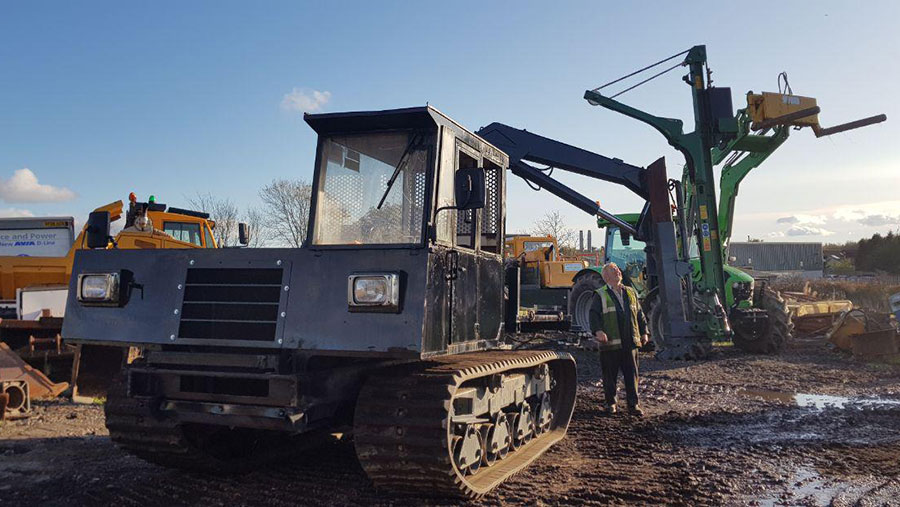Video: Smart farm maintenance inventions on a budget
The Farmers Weekly 2020 Farm Inventions Competition featured some smartly made farm equipment, such as a powered gravel cart, home-built flat-bed trailer and a nifty two-way log splitter.
Robert Wright’s ground-driven gravel cart (complex category highly commended)
Ground-driven implements are pretty common in wet areas such as mid-Ulster, so when a local drainage contractor asked Robert Wright to build a driven gravel cart for an employee with health issues, he got straight to work.
See also: How to tackle rust by galvanising farm kit
His first job was to work out the diameter of the large flotation wheels needed on the trailer.
A scrap axle from an 18t Volvo lorry then determined the width of the machine and allowed Mr Wright to make the modifications needed to the rims for it to be as narrow as possible for road transport.
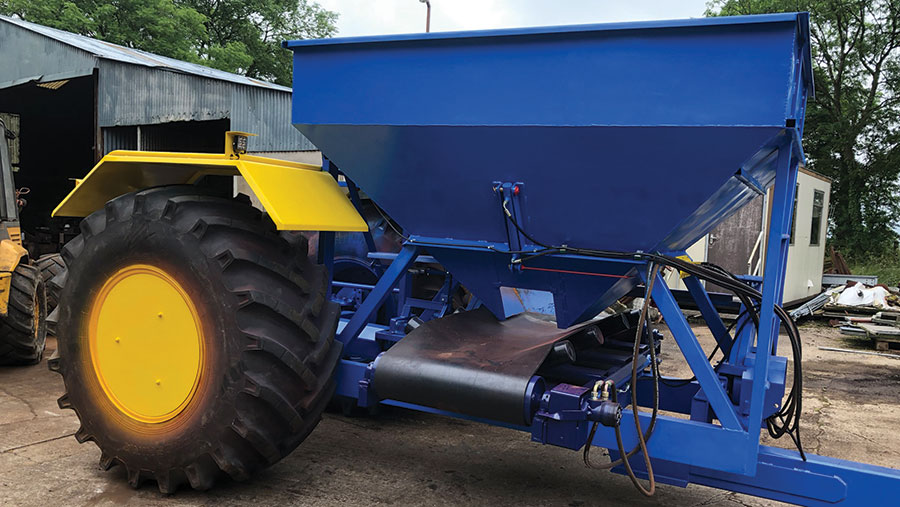
The complicated process of making it ground driven originally had the gearbox for the trailer drive at the front of the machine, directly in line from the pto drive on the tractor.
But Mr Wright was cautious, as when going down the road at 50kph, it wouldn’t take much for the gears to walk and the whole setup to go bang.
He then switched the gearbox to the rear, where it was set in its own sub-chassis within the trailer’s larger chassis. It was far enough away from the rear axle differential for two universal joints to be used as connectors and allow for any alignment tweaks.
Crucially, these were still strong enough to transmit the drive to the axle.
The gearbox was turned around so reverse gear was used to match the rotation of the tractor and provide drive to the rear axle.
At the other end of the gearbox, where the clutch would be, a modified sprocket was added to take the chain drive from here and link it via three other sprockets to the front of the machine. This setup was needed to get around the 10t gravel hopper.
By doing this, getting the timing spot on between the tractor’s ground drive and the rotation of the gravel cart’s wheels was made easier, as there were multiple adjustment points along the drive line. Mr Wright settled on a 1% variance over a 50m distance.
Once at this stage Mr Wright needed a way to disengage the drive for road transport. He used the gear selector on the transmission to change the drive from reverse to neutral. That meant drive still came from the tractor, as the pto remained connected, but nothing was transferred through the gearbox to the trailer’s axle.
He employed a 12V linear actuator with a 50mm stroke and a force of 150kg, which is equivalent to a person trying to engage a gear without the clutch. He hooked it up to a rocker switch in the cab and it takes about three seconds to change gear, while a warning light denotes the gear position.
It’s best done at slow speeds, as any gears that aren’t aligned quite right can move to allow the lever to engage. The complicated build took about six months to complete and has meant that a driver in poor health can operate the gravel cart without having to get off the seat.
It cost £6,000-£7,000 to complete.
Andrew Burt’s tilt-bed trailer (complex category highly commended)
Having searched for and failed to find a rattle-free tilt-bed trailer, Andrew Burt decided to make one himself.
The tandem-axle design uses high-quality German-built running gear, heavy-duty pivots and folding aluminium rear ramps that don’t rattle around and jam up.
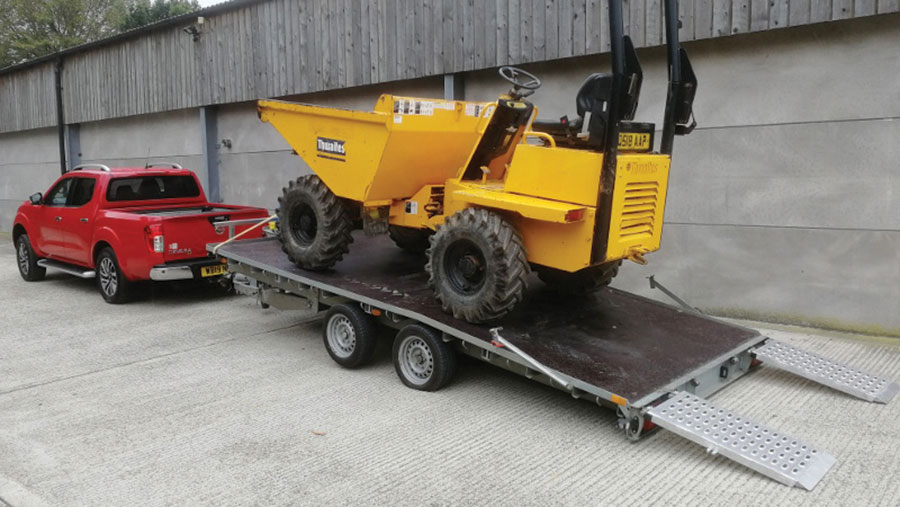
He also incorporated a slight beavertail into the deck that allows the rams to be kept short, making them easier to handle. Twin tilt rams hooked up to electric controls mean there is no manual pumping required, either.
Mr Burt designed the trailer to have a 3,500kg gross weight and had the complete chassis galvanised to prolong its life. He did all of the work himself, but had some of the more complex components laser cut. Apparently, it is almost silent during towing.
Ieuan Evans’ shed roof cleaner
Ieuan Evans has come up with an ingenious answer to mossy shed roofs.
His brilliantly simple scraper solves the age-old challenge of cleaning dangerously fragile roofs that may have built up several decades’ worth of green matter.
Central to the assembly is an axle and wheel combination from an old ride-on pedal tractor. The blown plastic wheels are lightweight and chunky, allowing them to ride over delicate sky lights and traverse the uneven profiles of roofing sheets.
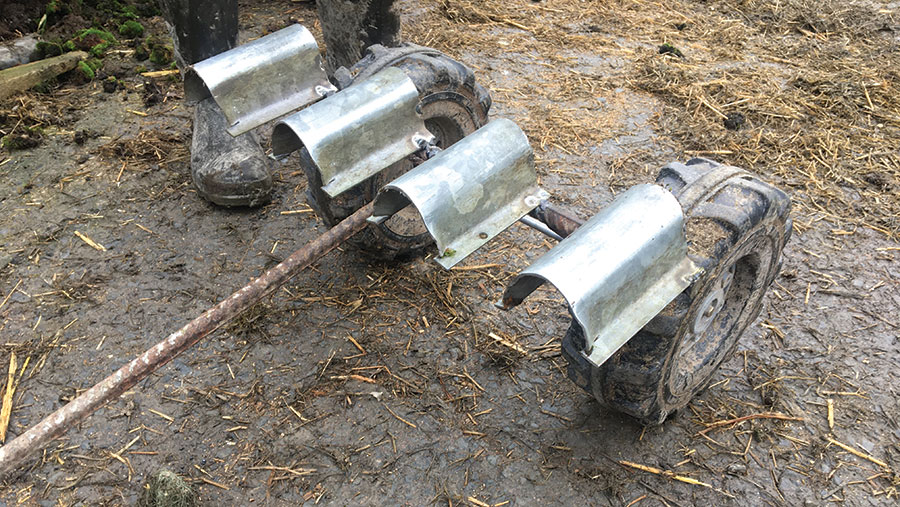
To the running gear, Mr Evans welded recycled steel reinforcing bar carrying four thin-edged, U-shaped scrapers. There were made from semi-circular cable ducting scavenged from old electric posts and run in the channels of the corrugated roof, dragging the moss down to the gutter ready to be cleared.
The whole lot is connected to a long T-bar handle, which allows the operator – from the safety of a lifting platform – to run the cleaner up the roof on its wheels, before flipping it over (with the wheels in the air) to scrape back down.
Of course, anyone that decides to build a similar version should use caution when working on roofs that may contain asbestos.
Graham Jackson’s stationary engine
An engine from a scrapped John Deere combine has been given a new lease of life by Graham Jackson, based in Little Eccleston, Lancashire, as a means of powering the farm’s Master grain dryer.
He had previously used a spare tractor for the job, but decided it was drinking too much fuel and, with the engine thrashing away at high revs and in dusty conditions all day, it was at risk of seizing.
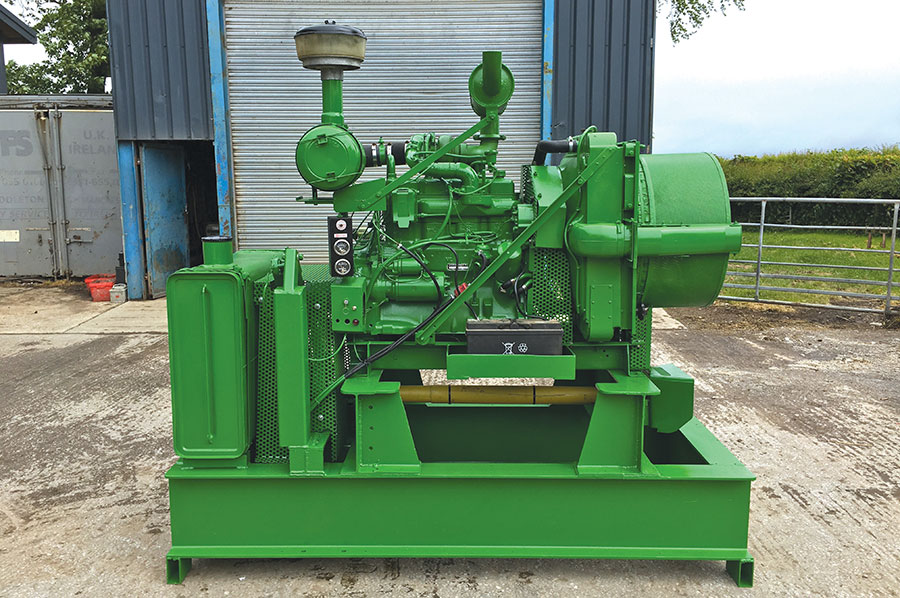
Instead, Mr Jackson sourced an old four-cylinder, 90hp oil-burner and mounted it to a solid RSJ base frame.
Both the original diesel tank and rotating air pre-cleaner were salvaged; with the latter particularly useful in keeping the radiator clean and cool while drying dusty barley.
To avoid the complications of a gearbox, drive is simply engaged by a hydraulic ram that tensions a set of upgraded Kevlar belts.
Mr Jackson also bought a £400 auto shut-off kit from the US that kills the engine if oil pressure and coolant temperature exceed set levels.
It runs impressively smoothly at 1,500rpm too – so much so that it doesn’t need bolting to the ground. It’ll also run all day on less than 136 litres of fuel.
The build cost left a handful of change from £3,000.
David Devine’s log splitter
This nifty two-way log splitter is the work of County Londonderry farmer David Devine.
It has a double-edged splitter and uses two rams – one pulling and one pushing – to give even splitting power in both directions. These are controlled by one half of a Ford 10-series double spool block with adjustable detent.
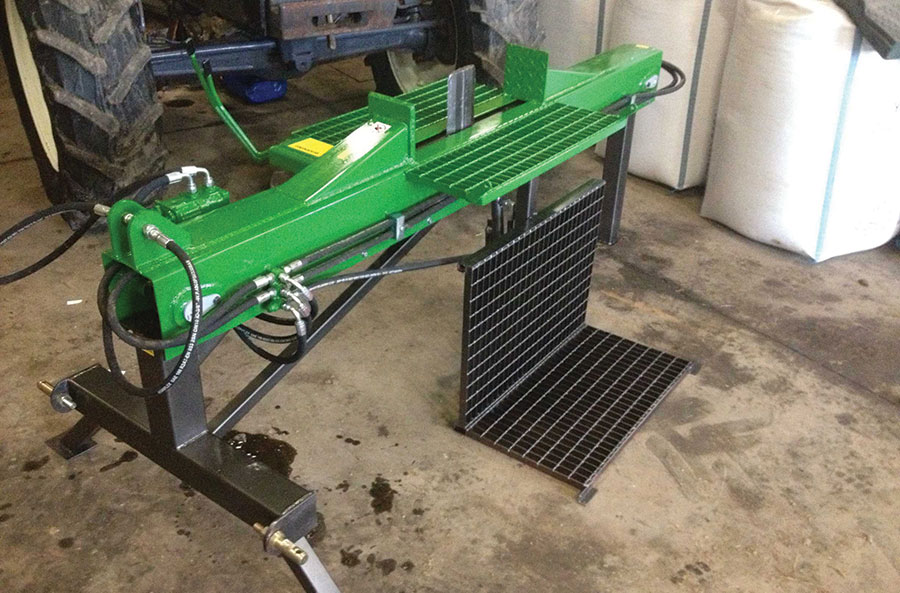
Mr Devine has also incorporated a hydraulic log lifter on the side of the table, which can be left up to give a larger working area. This has a separate ram that is controlled by the other half of the spool block.
Apparently, it more than doubles splitting time, as the long ram stroke means it’s often possible to split two logs at once.
Edward Ward’s road grader
As he needed to keep more than seven miles of tracks in good order, Lincolnshire farmer Edward Ward took a redundant set of Massey Ferguson discs and converted them into a track leveller.
The build took about a day to complete and began with removing the disc gangs. He kept the hydraulic drawbar pitch, as it is handy for levelling up the U-shaped blade when working on different tractors and uneven ground.
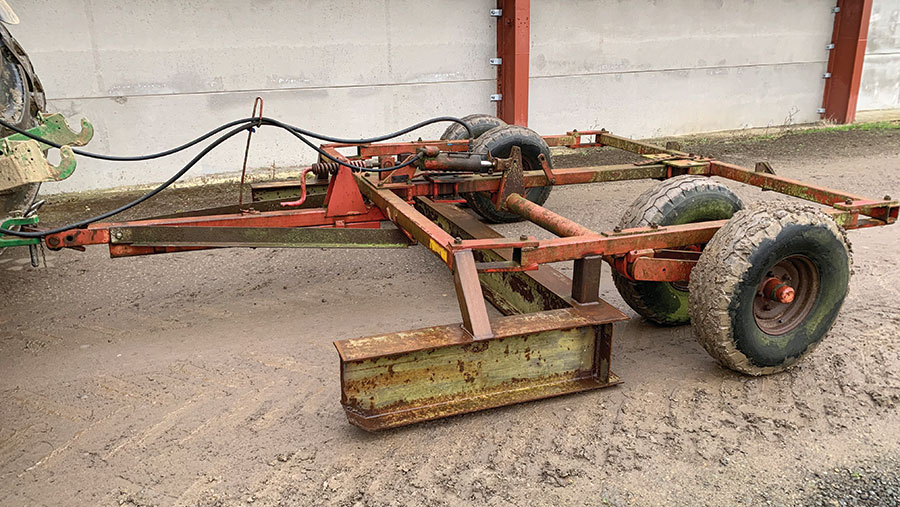
The wheels were also retained from the discs to lift and lower the blade into action. So far, it has covered about two miles of farm tracks, levelling humps in the middle of tracks as well as grading out piles of tipped stone.
The costs included welding rods and the time it took to build.
Ieuan Thomas’ electric scooter
It’s torture for most young people growing up on farms to look at machinery, but not be allowed to drive it. This is why 15-year-old Ieuan Thomas decided to build a scooter so he could help out with general tasks.
Most of the parts came from scrap lying around the farm, and power is provided by a couple of 12V batteries that run an old motor his grandfather had used on a previous project.
It has an electromagnetic brake system that slows the motor down once the drive is stopped.
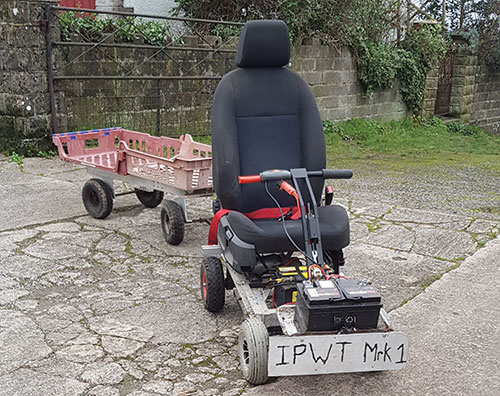
The front wheels are from an old mobility scooter that was being chucked out by a local shop and the seat was pinched from Mr Thomas’ grandfather’s old 2008 Ford Focus, that failed its MOT.
All in, the build cost about £20 and took two weeks to build in his spare time. It has proved very useful transporting everything from feed bags to bales around the yard.
James Park’s track grader
Living at the end of a long farm track sounds idyllic, but the combination of heavy farm traffic and wet Lancashire weather meant James Park was regularly dodging potholes on his route home.
Previously, he would fill in the potholes with a shovel, which was not only hard work, it took up valuable hours, so last year he decided to speed the job up by building a tractor-mounted leveller from scrap angle iron.
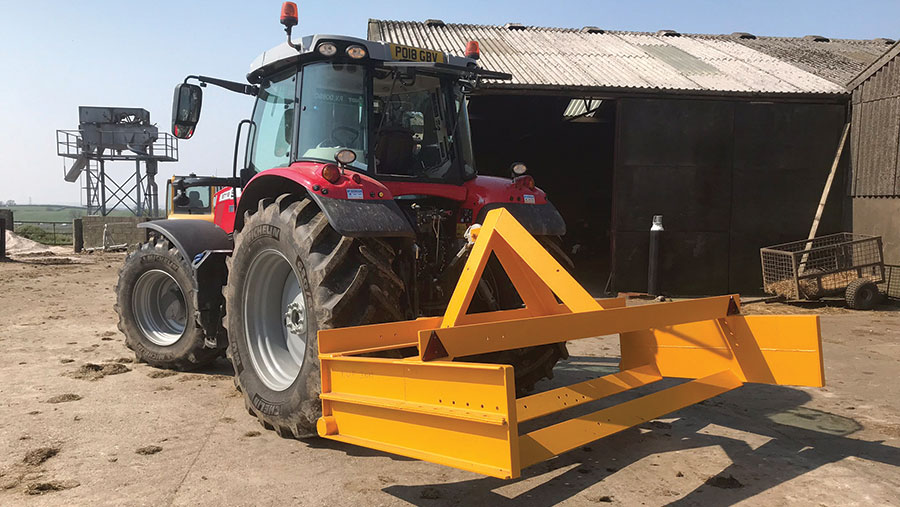
The clever design uses the iron cross members welded at 10deg angles to shave off the high spots and fill in the low areas. The high sides also mean material isn’t lost onto already graded areas.
Mr Park can also adjust the link arms so he can grade a camber onto the track, and it is used on average four times a year.
The 2.7m-wide frame is made from weighty offcuts of metal pylons and can be pushed or pulled by the farm’s Massey Ferguson 6716S.
There was little cost to the project and it took about three days on and off to knock together.
Lloyd and Pete Mortimore’s wrap compressor
Since adopting big-bale forage, organic beef farmers Lloyd and Pete Mortimore needed to come up with a way of neatly managing their used wrap.
The solution was to build a DIY compressing bay at their Dartmoor farm, which uses an intermediate bulk container (IBC) full of water to squash the material, making it easier to store and cheaper to dispose of.
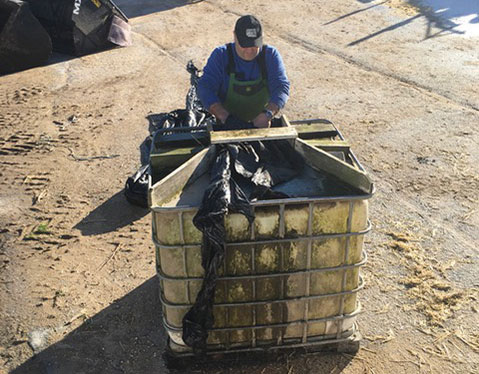
On the top on the IBC, the pair have fashioned a simple rolling table with a guide that keeps the wrap clean and allows it to be formed into neat, uniform pellets.
These are then stacked on a pallet in the bulker and when this is full, the IBC is placed on top to compress them. More wraps are added and compressed until no more can be accommodated.
In total, about 300 wraps can be fitted onto a pallet, at which point it’s removed from the bunker and the load is secured using more used wrap.
It’s then easy to take to a recycling centre, where they are given a discounted rate for bringing in clean, sorted material.
Phil Metcalfe’s suspended grain conveyor
After a quote for a full-length transverse grain conveyor was considered too expensive, Yorkshire farmer Phillip Metcalfe decided to have a go at building his own.
The base of the project was a second-hand conveyor that received a full refurb before installation. Two steel tracks at either end keep it suspended and move it up and down the grain store via wire rope pulleys, operated from the ground.
Most of the steel tracking had a previous life on the farm before being repurposed.
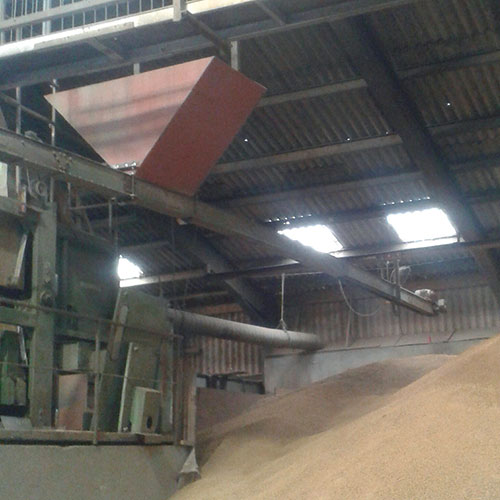
A large red hopper receives the grain from an overhead chain and flight conveyer, which has a number of outlets fitted with swivelling spouts to help transfer the grain. The main conveyor is bottomless, so allows for a level fill and better air movement due as it is not pushed with a loader.
Fan pedestals are also put in the crop to help the air flow.
Once a bay is full, a light is illuminated by a level sensor to alert the grain store operative to move the conveyor forward about 50cm for it to continue filling the bay.
New parts included the steel for the red hopper and the nylon wheels used for the track runners. The winding mechanism to move the conveyor was all fabricated from existing parts.
A new motor for the conveyor was installed by an electrician and the final cost was approximately 15% of the initial quote and was built last year in the farm’s workshop.
Chris Barker’s novel trailer catch
Fed up of filling his boots with grain every time he unlatched his trailer’s tailgate, Yorkshire farmer Chris Barker developed a low-cost solution that keeps a safe distance between the grain and his boots.
The design focuses on a length of baler twine that is tied to the top of the trailer’s tailgate. One end is threaded through the lower catch and then hooked back onto the longer end that runs down the length of the trailer.
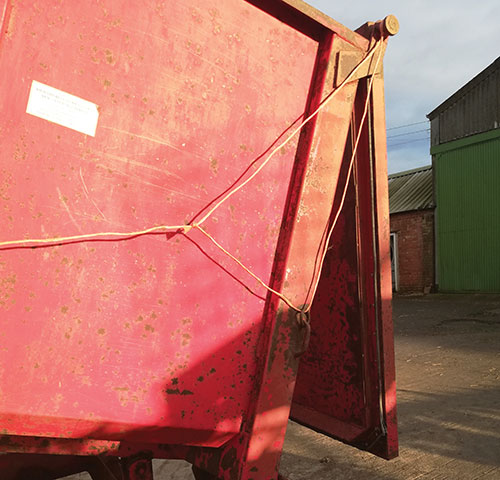
When the string is pulled, it tugs on the catch, lifting it off the bar and releasing the gate. Mr Barker says it avoids countless boot empties a day and the colour of the twine is optional. And the cost is “Yorkshire’s favourite price”, he says.
Peter McLaughlin’s people carrier and post knocker
North Ayrshire farmer Peter McLaughlin converted an old Canycom tracked dumper into a people carrier capable of carting four people to remote areas.
The low-ground-pressure machine has a 1,400x600mm storage area that has a 1,000kg payload and helps to deliver personnel and tools to hard-to-reach jobs.
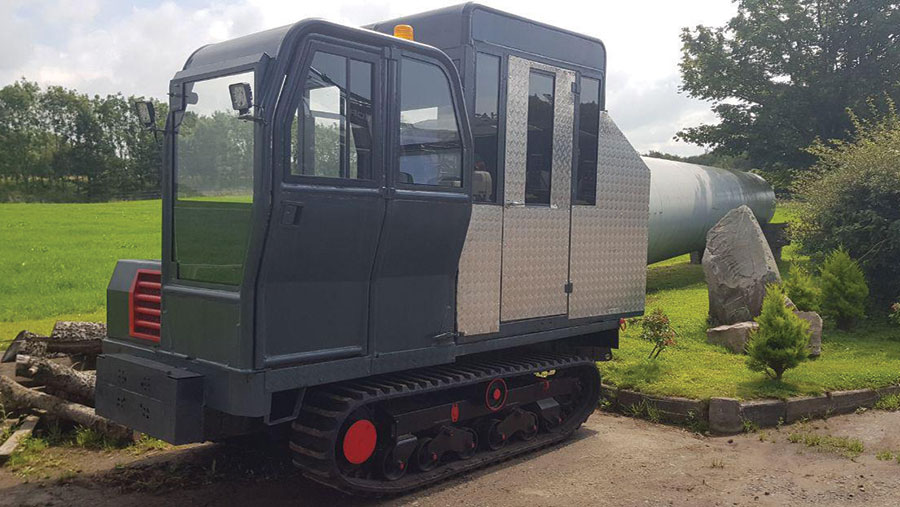
Mr McLaughlin also fitted a crane and a Wrag post driver to a 5t Morooka tracked dumper. It has the capacity to carry lots of fencing kit and is driven by the hydraulic levers at the rear of the machine.
The post driver can swivel 180deg to help the operator get the right distances and angles to knock the posts into the ground.
